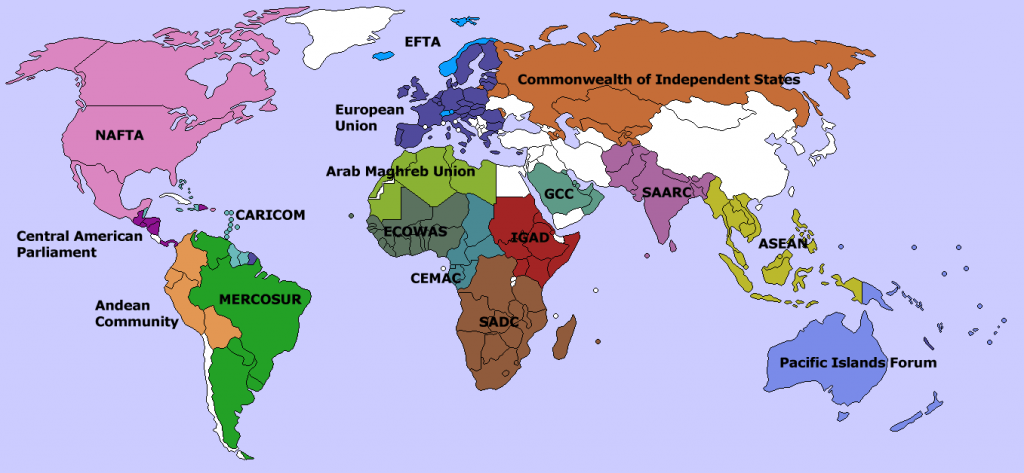Difference Between Dual federalism and Cooperative federalism
Introduction:
Federalism is a politico-administrative structure where multiple governments function and rule a given territory and a set of people. In a federal system the sovereignty of a country is constitutionally divided between a central or national government and other state or provincial governments where political and administrative powers are shared between them. In this overarching system the union government and the state governments take and implement decisions through negotiations, at the same time maintaining regional identity and liberty but remaining united as a nation in a bigger political formation headed by the national government. USA, India, Germany, Australia, Canada, Nigeria are the examples where federal system of governance is in vogue.
Evolution
The history of American Republic from 1789 to 1945 was witness to dual structure of federalism. The Constitution of the US clearly outlined two kinds of governments; national government and state governments. Powers relating to defence, foreign policy, and international trade were bestowed on the national government, and state governments’ powers enumerated were related to regional matters, economic regulations, and criminal laws. The constitution left no grey area or chance of overlapping of powers and responsibilities, vis-a-vis the central and state governments.
During the major part of the last century, federalism has evolved around the concept of cooperation between national government and the state governments. The federal government and the state governments came closer and gave a cooperative form to the federal system of governance.
Differences
1. Dual federalism is a political system where the responsibilities and powers of the federal government and the state governments are distinctly separated. The state governments exercise powers without any interference from the national government. Dual federalism is also referred to as ‘layer cake’ federalism due to the clear presence of layer in the cake.
In the cooperative federalism, the line of distinction between the powers and responsibilities of the national government and the state governments is blurred.
2. In dual federalism the national government and the state governments have different spheres, and both are sovereign in their respective sphere.
In cooperative federalism, no such separate spheres exist, and both the governments work in tandem, even in matters of formulating policies.
3. The national government and the state governments share powers and responsibilities in a horizontal fashion in a dual federal structure. This leaves areas of tension between the two.
In cooperative federalism the powers and responsibilities structure is vertical. Here cooperation is a two-way traffic.
4. Dual federalism accepts the powers of state governments. Some of the powers of the state governments are equal to that of the national government.
Cooperative federalism emphasises on cooperation between national government and the state governments. The system does not believe in any wall between powers and responsibilities of the national government and that of the state governments.
5. The tenth amendment to the US Constitution reserves powers for the state governments. Dual federalists insist that the powers not assigned to the central government must bestow upon the state governments, and rejects flexibility of the elastic clause. Cooperative federalists insist on limited application of the tenth amendment.
6. Dual federalism is a rigid structure. Due to this, complex issues can’t be resolved decisively and quickly. Cooperative federalism holds more flexibility, and provides more practical approach to inter governmental relation.
7. Dual federalism fosters application of democratic principles and state governments can prevent the national governments from abusing power. Cooperative federalism is less conducive to such things.
8. Dual federalism promotes competitive democracy between the states. The more powerful states can bully less powerful ones in matters of allocation of natural resources.
Summary
1. Both the concepts of dual federalism and cooperative federalism have originated in the USA.
2. Dual federalism is referred to as layer cake due to the existence of distinct wall between powers and responsibilities of national governments and that of state governments. Cooperative federalism is referred to as marble cake.
3. Dual federalism has horizontal power structure between national and state governments where as cooperative federalism has a vertical structure between the two.
4. In dual federalism national government and state governments enjoy sovereignty in their respective fields. No such thing exists in cooperative federalism.
5 Dual federalism is a rigid structure where as cooperative federalism is a flexible structure.
6. Dual federalism promotes competition and tension, cooperative federalism promotes cooperation.
Bibliography:
1. Difference between Dual and Cooperative Federalism. Nava Academy. Retrieved from www.studymode.com
2. William T. Bianco, & David T. Canon, American Politics Today. www.wwnorton.com
- Difference Between Vascular Cambium and Cork Cambium - November 1, 2023
- Difference Between DevOps and Developer - September 10, 2023
- Difference Between Acute Gastritis and Chronic Gastritis - April 3, 2023
Search DifferenceBetween.net :
Leave a Response
References :
[0]http://en.wikipedia.org/wiki/Supranational_union

